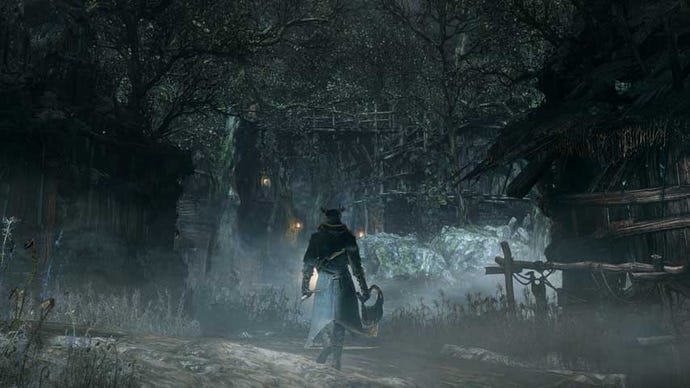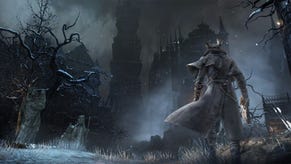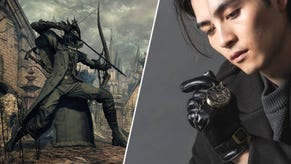Bloodborne guide: controls and gameplay explanation
Bloodborne takes a different approach to combat and gameplay than Demon's Souls and Dark Souls. Let's cover the basics.
Bloodborne guide: controls and gameplay explanation
Bloodborne is a challenging RPG with action combat and puzzling, dangerous exploration. It is played in third-person. At the heart of it, you advance through the environment, chopping down foes until you reach the boss of a particular section, which you must defeat to progress through the game. Environments are linked by unlockable shortcuts, and players have some freedom of choice as to which area they tackle first.
Here are the basic controls:
Veterans won't find much to surprise them here, but some key changes for returning players include:
- dedicated healing item button (Triangle)
- transforming weapons (L1)
- firearms (L2)
- no parry or counters; see combat guide for new alternatives
Advanced controls are as follows:
- gestures: left half touch pad OR hold X and use motion controls
- secondary item quickslots: right half touch pad
- emergency ammunition refill (consumes health): D-pad up
- open menu: Options key
- jump: circle while sprinting
- move up or down ladders more quickly: hold circle while moving
- add gesture to message: press L1 while composing
Bloodborne: key game concepts
Bloodborne's main currency is called Blood Echoes. It's used to level up your character at the Hunter's Dream hub and purchase new equipment.
You are expected to die a lot in Bloodborne. Upon death, you'll be transported back to the nearest Lantern - which can be quite far away - and lose all the Blood Echoes (currency) you were carrying at time of death. When this happens, or you choose to return to Hunter's Dream and then come back, all defeated enemies will be resurrected.
If you can make it back to where you died without succumbing again, you can collect your lost Blood Echoes. Be warned, though: if you die again, they'll be lost forever. Nearby enemies can also steal the dropped Blood Echoes, and you'll have to defeat them to get your cash back. The enemy you're looking for has glowing eyes.
A secondary currency called Insight is used to initiate multiplayer matches (PvP and co-op), as well as purchase items from a dedicated Insight shop. Insight is gained by defeating bosses, as well as by using items and speaking with NPCs. As Insight increases the player will experience new phenomena in the environment, like new kinds of enemies, variations in enemy attack patterns, and environmental changes. Read our detailed Insight guide for more.
You can heal yourself using a consumable item called the Blood Vial, mapped to Triangle. You can carry 20 at a time, and store up to 99 at the Hunter's Dream Hub. Excess collected Blood Vials are automatically put into storage. When you die, or enter Hunter's Dream from the waking world, your stash of 20 will be automatically refilled from storage if possible.
Represented by a green bar, Stamina is one of the most important concepts in Bloodborne. Both evading and attacking require and consume Stamina. It regenerates over time, but managing it is the key to combat.
While players can equip firearms, melee combat is the focus of the game. Transforming blade weapons can take on multiple forms, usually a fast-but-light version and a slower, longer one. Use the one that suits your playstyle and the enemies at hand, but be aware that you can transform mid-combo, and the transformation is itself an attack.
Weapons degrade with use and must be repaired at the Hunter's Dream hub when broken.
If you take a hit in combat you have a chance to earn your health back thanks to the Regain system. Upon being damaged by an enemy, a section of your health bar will turn orange. You have a short window in which to inflict melee damage on enemies; if successful, the section of your health bar will be refilled.
Apart from the Blood Vial, consumable items must be mapped in the game menu to quickslots (selectable via D-pad), after which they are activated by pressing Square. Pebbles and Rocks are key consumables; use these to distract foes so you can sneak by, or lure one enemy away from a group so you can battle in safety.
As you explore you'll frequently encounter Messengers. From Software uses these to provide tutorial prompts in the initial areas, but beyond that the majority will be left by other players, and are not necessarily trustworthy. You can leave your own messages once you have the Notebook item.
Time passes in the Bloodborne game world when you defeat bosses. You'll notice the sun sinking and the moon rising, as it gets darker and darker. Some things will change as time advances - NPCs will move, opporunities will open and close, and enemies may behave differently.










